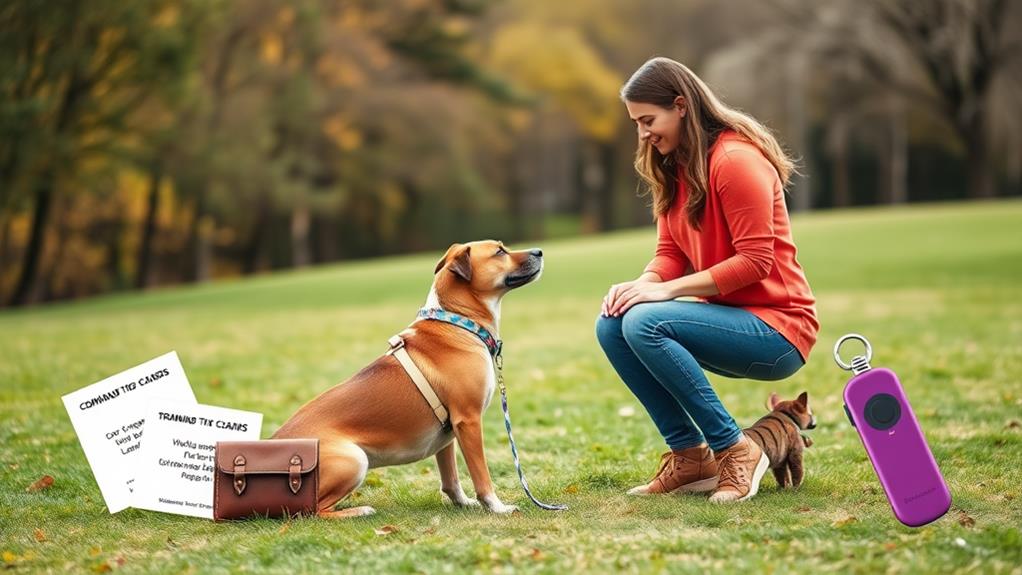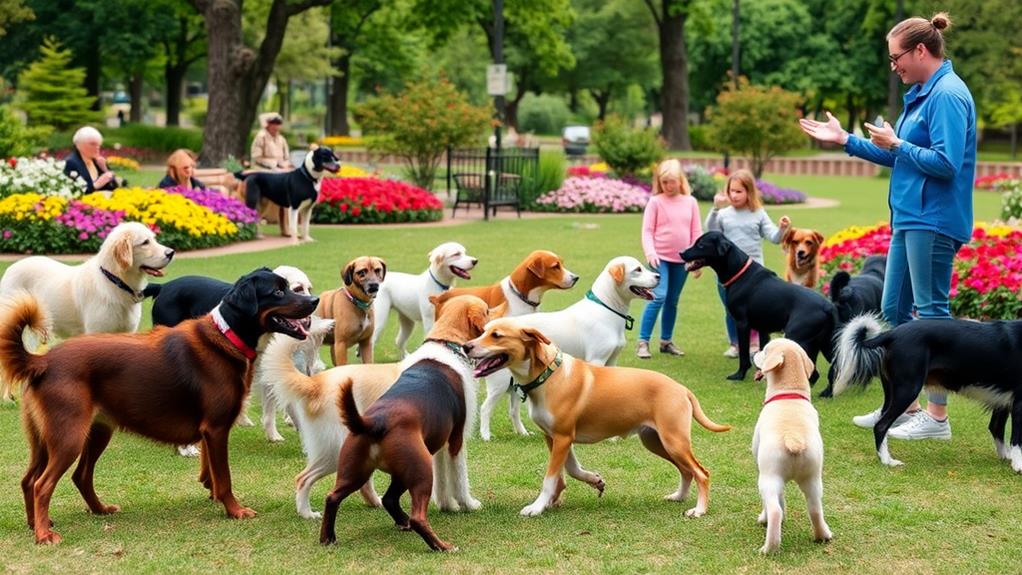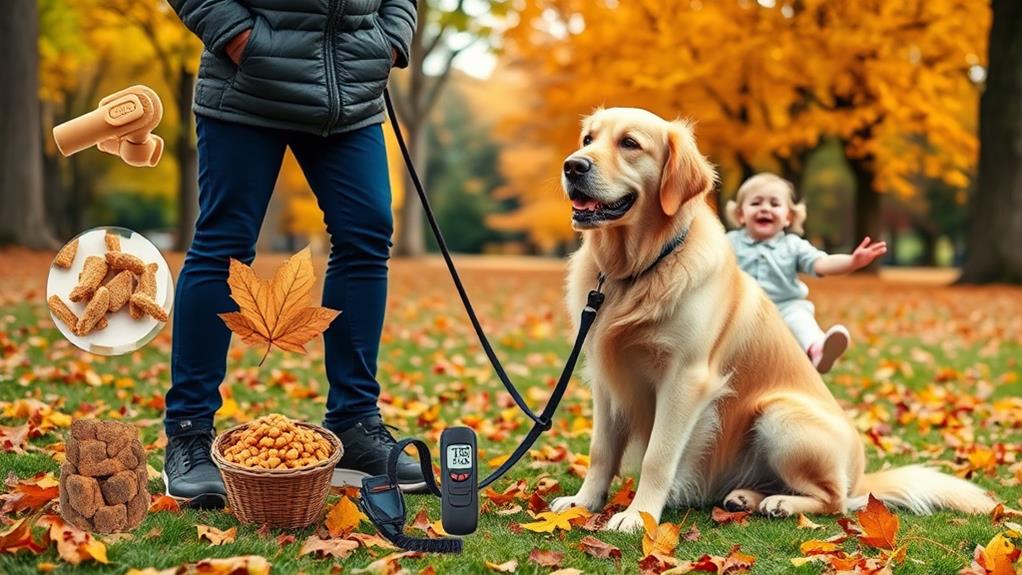To raise a well-behaved pup, you need to focus on three essential training tips. First, use consistent commands to guarantee your dog comprehends what you anticipate. This helps build a strong training foundation. Second, incorporate positive reinforcement by rewarding good behavior with treats, praise, or playtime to strengthen the bond. Finally, provide plenty of socialization opportunities by exposing your dog to new environments, people, and other pets. These experiences cultivate a confident and friendly demeanor. Stick around, and you'll find even more strategies to enhance your pup's training and overall behavior.
Consistent Command Use

When it comes to dog obedience training, using consistent commands is essential for your pup's understanding. Dogs thrive on routine and repetition, so sticking to the same words for each command helps them grasp what you want. For instance, if you choose "sit," don't switch to "sit down" or "take a seat." Consistency reinforces learning and builds a strong foundation for your dog's training.
Make sure everyone in your household uses the same commands. If one person says "stay" while another says "wait," it confuses your dog and slows down progress. It's best to create a list of commands you'll use and share it with everyone involved in your dog's care.
Additionally, keep your tone and body language consistent. Dogs pick up on cues from your voice and movements, so use a firm but friendly tone, paired with the same gestures for each command. This clarity helps your dog recognize and respond correctly.
Lastly, practice regularly. Repetition solidifies your pup's understanding, making it easier for them to follow your commands in various situations. Consistent command use lays the groundwork for a well-behaved, obedient dog.
Positive Reinforcement Techniques

To effectively train your dog, incorporating positive reinforcement techniques is key, as this approach encourages desired behaviors through rewards. By rewarding your pup for good behavior, you're building a strong bond and motivating them to repeat those actions.
Start by identifying what your dog values most—treats, praise, or playtime. Use these rewards consistently when your dog follows commands or behaves well. For instance, if your dog sits on command, immediately offer a treat and enthusiastic praise. Timing is vital; reward them right after the behavior to reinforce the connection.
Make sure to keep the training sessions short and fun. Dogs have short attention spans, so aim for 5 to 10 minutes per session, gradually increasing duration as they learn. If your dog struggles with a command, be patient and break it down into smaller steps. Celebrate small victories to keep your dog engaged.
Avoid using negative reinforcement, as it can create fear and anxiety. Instead, focus on positive interactions that encourage your dog to learn and grow. With consistent application of positive reinforcement, you'll see improvements in your pup's behavior and responsiveness.
Socialization Opportunities

Socialization opportunities play an essential role in your dog's development and overall behavior. By exposing your pup to various environments, people, and other animals, you help them learn how to interact appropriately. Start early—puppies are most receptive to new experiences between 3 and 14 weeks. Take advantage of this critical window to introduce them to different sights, sounds, and smells.
Regular trips to the dog park, busy streets, or pet-friendly stores can provide valuable experiences. Encourage positive interactions with other dogs and people, and always supervise these encounters. If your dog seems anxious or overwhelmed, don't force them; instead, give them a break and try again later.
Group training classes are another fantastic way to socialize your dog while reinforcing obedience training. They not only expose your dog to various distractions but also help them learn to focus on you amidst the excitement. Remember, the goal is to create a well-rounded pup who feels comfortable in diverse settings. With consistent socialization, you'll foster a confident, friendly dog who's ready to take on the world with you by their side.
Frequently Asked Questions
How Long Should Training Sessions Last for Optimal Results?
Training sessions should last about 5 to 15 minutes for ideal results. Keeping it short helps maintain your pup's focus and enthusiasm. You'll see better progress when sessions are fun and engaging for both of you.
What Age Is Ideal to Start Obedience Training?
You might think waiting until your dog's a teenager is wise, but starting obedience training as early as 8 weeks old is actually ideal. Trust me, you'll want a well-mannered pup before those rebellious years hit!
Can Older Dogs Learn New Commands Effectively?
Absolutely, older dogs can learn new commands effectively! Their experience and maturity often make them more concentrated and keen to please. Just be patient, use positive reinforcement, and keep training sessions short and engaging.
How Do I Handle a Stubborn or Resistant Dog?
Isn't it frustrating when your dog just won't listen? To handle a stubborn pup, stay patient, use positive reinforcement, and keep training sessions short. Consistency and encouragement can turn resistance into cooperation over time.
What Equipment Do I Need for Training?
To train your dog effectively, you'll need a sturdy leash, a comfortable collar or harness, high-value treats for rewards, and clicker or verbal cues. These tools help reinforce positive behaviors and strengthen your bond.
Conclusion
By weaving consistency, positivity, and socialization into your dog's training, you're crafting a beautiful tapestry of obedience and trust. Think of your pup as a budding flower, blossoming under the warmth of your guidance. With each command you consistently use, each treat you offer, and every new friend you introduce, you're nurturing their growth into a well-behaved companion. So, grab your leash and commence on this rewarding journey together—your bond will flourish like a garden in spring!



